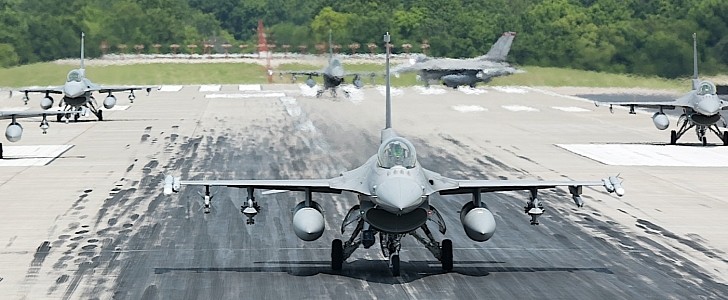There are many impressive things about military machines, but few come close to what is known in this field as an elephant walk. It is a term that describes a large number of military aircraft taxiing in close formation right before takeoff.
As you might have guessed, the term originates in the days of the Second World War, when large fleets of aircraft lined up on the runway before heading toward their designated targets. Story goes the term came be as those witnessing these massive events compared the aircraft with elephants lining up on a watering hole.
Even if none of the massive aircraft fleets that fought part in World War II took off from the American homeland, it was the U.S. Air Force (USAF) that liked the term the most, and adopted it.
After the war, when at times thousands of planes took part, the size of these elephant walks diminished. Last we heard of such a maneuver was back in January 2020, when tensions between the U.S. and Iran peaked, and America took out 52 combat-ready F-35A Lightnings and neatly lined them up on a runway for the enemies to see.
This week, USAF released an image from another elephant walk that took place at Tulsa Air National Guard Base in Oklahoma. There, during a large-scale readiness exercise, an undisclosed number of F-16 Vipers deployed with the 138th Fighter Wing took to the tarmac and then to the skies in formation.
The F-16 is a fighter plane initially manufactured by General Dynamics (it is now made by Lockheed Martin), and its official stage name is Fighting Falcon. For reasons that have with personal preferences, including some related to sci-fi series Battlestar Galactica, pilots flying these machines like to call them Vipers.
Deployed by a large number of countries, the F-16 can fly at speeds of over Mach 2 for as much as 2,620 miles (4,217 km) when drop tanks are involved. The plane is generally armed with rotary cannons, and a large number of missiles, rockets and bombs attached to its hardpoints.
Even if none of the massive aircraft fleets that fought part in World War II took off from the American homeland, it was the U.S. Air Force (USAF) that liked the term the most, and adopted it.
After the war, when at times thousands of planes took part, the size of these elephant walks diminished. Last we heard of such a maneuver was back in January 2020, when tensions between the U.S. and Iran peaked, and America took out 52 combat-ready F-35A Lightnings and neatly lined them up on a runway for the enemies to see.
This week, USAF released an image from another elephant walk that took place at Tulsa Air National Guard Base in Oklahoma. There, during a large-scale readiness exercise, an undisclosed number of F-16 Vipers deployed with the 138th Fighter Wing took to the tarmac and then to the skies in formation.
The F-16 is a fighter plane initially manufactured by General Dynamics (it is now made by Lockheed Martin), and its official stage name is Fighting Falcon. For reasons that have with personal preferences, including some related to sci-fi series Battlestar Galactica, pilots flying these machines like to call them Vipers.
Deployed by a large number of countries, the F-16 can fly at speeds of over Mach 2 for as much as 2,620 miles (4,217 km) when drop tanks are involved. The plane is generally armed with rotary cannons, and a large number of missiles, rockets and bombs attached to its hardpoints.

